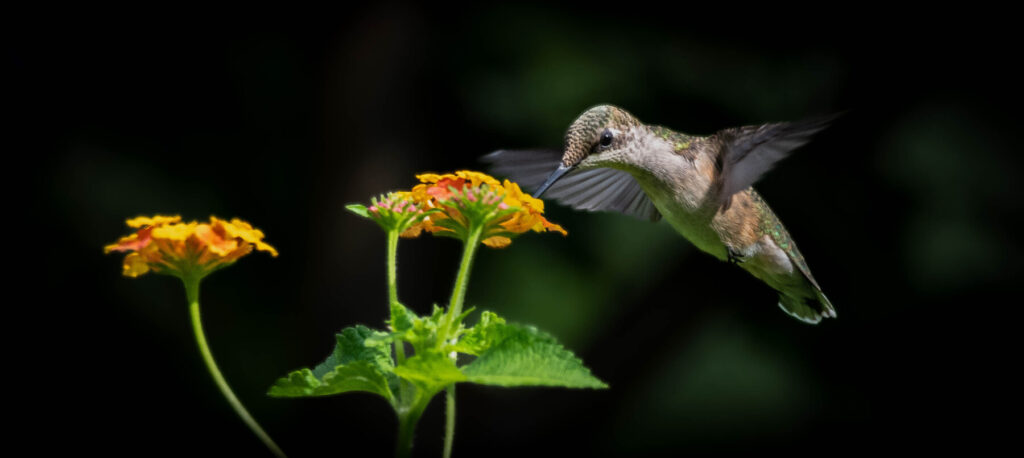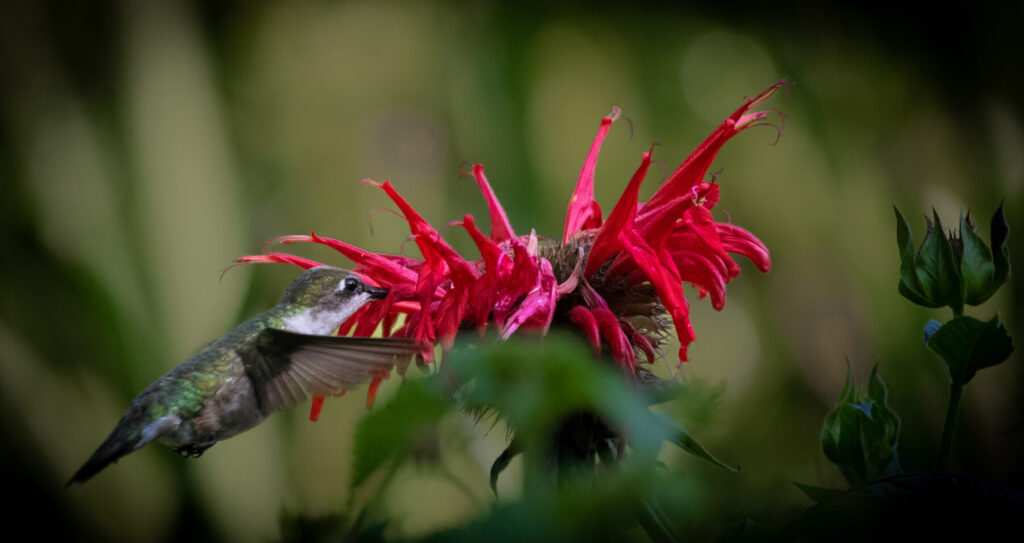
Ruby-throated Hummingbirds spend the spring, summer and early fall in Georgia. Feeders and flower gardens are great ways to attract these birds, and some people turn their yards into buzzing clouds of hummingbirds each summer. Ruby-throated Hummingbirds are eastern North America’s only breeding hummingbird.
A feeder with a simple sugar water solution of balance is 4-to-1 or 1 cup of water to 1/4 cup of sugar. Due to their extremely high metabolism, hummingbirds must visit hundreds of flowers a day—by making hummingbird nectar at home, you can help give these winged beauties the glucose energy they need to keep moving. The hummingbird feeders should be cleaned with a white vinegar and water solution each time you refill the feeder or at least weekly. Do not add red dye to solution.

Ruby-throated Hummingbirds prefer to feed on red or orange flowers. Like many birds, hummingbirds have good color vision and can see into the ultraviolet spectrum, which humans can’t see. No matter what growing zone you’re in, there are many plants to attract hummingbirds. Flowers include Bee Balm; Cardinal Flower; Zinnia; Salvia; Trumpet Creeper; Columbine: Petunia; Trumpet Honeysuckle; and others. Selecting flowers with long bloom times or repeat blooming means you’ll be treated to regular visits for many weeks.
Though nectar is important to hummingbirds, they also need a variety of small insects and arachnids — mites, mosquitoes, aphids, small bees, gnats, small spiders and the like. Some scientists say a typical Ruby throat Hummingbird diet during nesting season may be 50%-60% insects.
Mother hummingbirds feed their young almost exclusively on small insects and spiders to provide protein for the babies’ growth. Insects also provide essential vitamins, minerals, oils and fats that the birds don’t get from nectar.
Ruby-throated Hummingbird Facts
- The Hummingbird’s brain makes up 4.2% of its body weight. (Human brains makes up 2% of body weight.
- Hummingbirds have superb memories, the recognize humans, migration routes and every flower that they visited.
- The average Hummingbird weighs 3 grams, about the same weight as a penny.
- The name of the Ruby-throated Hummingbird stems from the appearance of the male. Males of the species have a bright red throat, while females have white colored throats.
- When constructing the small cup-shaped nest out of plant materials and spider silk, the mother hummingbird keeps it pliable. She will stomp down the base but leave the walls of the nest slightly flexible. This will allow the nest to stretch as the baby hummingbirds grow.
- Eggs incubate for about two weeks. The young can fly as soon as 20 days after hatching.
- Ruby-throated hummingbirds favor tubular flowers because of the great amount of nectar the flowers produce. Bees are unable to reach the nectar and pollen within tubular flowers, which allows hummingbirds to feed on these flowers without having to compete with bees.
- A hummingbird tongue is approximately the same length as their beak. When Ruby-throated hummingbirds stick their beak down into flowers, they are using their long tongues to reach the nectar that sits at the bottom.
- Pollen is very important for flower reproduction. Like bees, hummingbirds are excellent pollinators. As the hummingbird travels from flower to flower to feed on nectar, they pick up pollen with their feathers in the process.
- The legs of the Ruby-throated Hummingbird are so short that they can’t walk or hop around. When not in flight, they can use their strong feet to grip branches and sit perched.
- Ruby-throated Hummingbirds are active during the daytime and sleep at night.

The Ruby-throated Hummingbird is not considered threatened. It can often be attracted to yards with hummingbird feeders, but these can create a problem if placed in areas where they make hummingbirds easy prey for cats or other animals. The feeders also pose a risk if placed around windows that the birds may fly into.
Hummingbird season in Georgia is a magical time. Hummingbirds are not like other birds. They possess the ability to hover, fly forwards, backwards, straight-up, even upside-down, and at speeds up to 60 miles-per-hour when diving, these little aerialists make all other birds look slow and plodding by comparison. Enjoy these winged beauties.